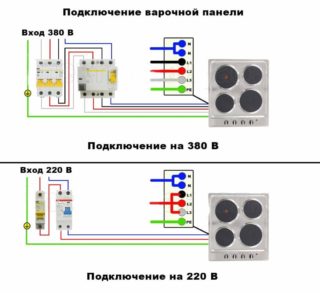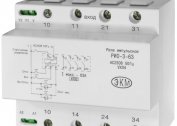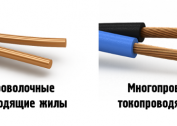The hob is a compact analogue of a stationary stove. The panel will not spoil any interior solution, because it does not stand out, the headset crashes into the countertop like a sink. The peculiarity of the inductive glass-ceramic surface is that it itself does not heat up, but transfers heat directly to the dishes.
Preparatory stage for panel installation
The idea of installing a hob constructively considered at the design stage of the electrical wiring. This allows you to choose the appropriate model for the power, wires, gouge a separate channel for the cable, install the desired outlet. The purchase is preceded by an analysis of the wiring in the house or apartment. A kitchen electric panel in place of an old stove will create a series of difficulties. Wiring in a house or apartment withstands its maximum allowable power value at the same time included devices. For small cars of the Khrushchevka type, this is 5.5 kW. The choice of electrical appliances may be limited by a low power range.
The inductive equipment program is able to independently cut off the heating of part of the burners. Cooking will become protracted, the panel will lose the main trump card - the heating rate. If you are not sure of the stability of the power supply network, avoid touch-sensitive cookers. In conditions of reduced or jumping voltage, they will behave whimsically.
In the absence of basic skills in wiring, entrust the connection to professionals. Failure to follow clear instructions and safety rules will have devastating consequences.
Materials for mounting electrical panels
 According to SP 31-110-2003, an individual power line of electrical wiring is organized under the power of electric stoves. Do not feed a branch from a kitchen junction box or other outlet. Do not use extension cords or network splitters.
According to SP 31-110-2003, an individual power line of electrical wiring is organized under the power of electric stoves. Do not feed a branch from a kitchen junction box or other outlet. Do not use extension cords or network splitters.
Power up to 3.5 kW allows you to use the usual 16 A Euro socket. The average consumption for modern functional models of cooking surfaces is 7–8 kW. In this case, you can not do without a 40 A power connector. The rules for connecting electrical appliances determine the location of the outlet: not higher than 90 cm from the floor, below the oven or away from it. Below is the indentation in case of flooding.
A plug connection for a current of 40 A overall - 5–7 cm. The gap between the wall and the kitchen unit will come out uncomfortable. An alternative is to remove the back wall of the cabinet or to cut a hole in it. The hob is connected to the power plug with a PVA wire or its equivalent, which is included in the equipment package.
The contacts of the supply wiring and the panel wires are connected directly using the GMD sleeves or mounting box. Such a connection complicates the wet cleaning of the surface. To de-energize the stove, it is necessary to turn off the circuit breaker in the switchboard each time.
The cable selection is calculated according to the formula based on the power consumed by the device. If the conductor is not thick enough, the circuit breaker will trip, otherwise the wiring itself will burn out or cause damage to the equipment. The material of the conductor is copper. Suitable cable types are marked VVGNG-Ls or NYM. The cross section of the cores can be calculated independently with reference to the PUE table. 3 * 6 mm2 is a universal option if a decision has not yet been made in favor of a specific model.
The ends of the conductor cleaned from insulation are formed into monolithic pins by pressing with NSHV tips. The branch of the circuit is protected by an RCD device or a difavtomat.
Inductive surface power circuit
Connection of the line in the distribution panel
 A single-phase network involves the use of a two-pole protective device, a three-phase network - an automatic machine with four poles. The leakage current index is usually 30–40 A, but for energy consumers with power above 7.2 kW, 25 A is safer.
A single-phase network involves the use of a two-pole protective device, a three-phase network - an automatic machine with four poles. The leakage current index is usually 30–40 A, but for energy consumers with power above 7.2 kW, 25 A is safer.
The cable outputs in the brown, black and white windings are phases that are suitable for the circuit breaker from below with bolts marked 1, 2, 3. Zero in the blue insulation is fixed to N. The yellow-green protective conductor is led to the ground bus.
Junction box in the socket
Power pair - detachable connection. An outlet for an induction cooker usually has 3 pins. To connect the cable, it must be disassembled, cleaned the wires of the PVA cable from insulation. Phase and zero are fixed on the side contacts, guided by the marking. If the wire of the plate has 4 or 5 outputs, one or two pairs are connected by crimping under a common tip. You can twist the black wire with brown, and gray with blue. The reception is not entirely safe, because the ground wire is half the thickness of the working conductors, which is contrary to the norms. Alternatively, excess ends are isolated and retracted. In this case, the appliance may cause malfunctions, and not all heating fields will be switched on.
Instead of a plug-in connection, a block with two rows of terminals is used - a connector. Dimensions of the mounting box 100 * 100 * 50 mm. Pairs of screws from top to bottom or from left to right fix incoming and outgoing phases, zero and ground. The disadvantage of such devices is that they do not always withstand the given power. For three-phase connections, a spring convector is sufficient (current pass up to 24 A), for single-phase connections, a screw (36 A) is required. The priority is given to the KlK – 5S model.
Conductors are combined with consumer wires using sleeves. The diameter of the tubular products from electrical copper is selected according to the cross section of the cable. If the thickness of the conductors at the ends of the sleeve is different, a thinner seal with an additional wire. The edges of the sleeve are clamped by presses with pliers (pliers are not suitable for this task), wrapped with electrical tape or fused with a heat shrink tube. Connected lines are neatly placed in the socket. The method requires the contractor to experience and have a special tool.
Connect the hob to the mains
The contacts come out in the lower part of the hob: wires are released or a block with terminals (3–6 pieces) is decorated. The kit includes metal jumpers. When connected to a three-phase line, all terminals are involved. This option is rarely used, more often they take two phases for ease of distribution over the burners. Two areas of medium heating will be in one phase, and strong and weak in the second. The third wire is isolated and removed.
Free terminals with the involved are combined in a single-phase connection in parallel with plate adapters.
Typical schemes of electrical appliances of famous brands
 How to connect the hob to electricity correctly, the manufacturer's instructions will tell. Models of different production by the terminal block device differ slightly.
How to connect the hob to electricity correctly, the manufacturer's instructions will tell. Models of different production by the terminal block device differ slightly.
Bosch brand in a row arranged five contacts: 3 to all phases of a three-phase network and 2 to zero. The ground connection is isolated and used for all types of connection. In a single-phase and two-phase connection between 1, 2, 3 or 1, 2, metal jumpers are placed, the core is attached to 3 or 2, 3, respectively. A jumper is used between 4, 5. The working zero is attached to 5.
Hansa placed the outputs on phases 1, 2, 3 on the left - jumpers are used in the connection to the network with a lower phase, but the cores are fixed to 1 or 1, 2 terminals. On the right is the contact for zero (4) and for grounding.
In Electrolux, 4 or 5 bolts are placed in a row. Above are 3 phase or 2 and a free cell, below is neutral and earth.
A practical kitchen assistant will turn into a source of danger in case of violation of installation technology. Connecting the hob to the home electrical system yourself can be facilitated by the correct choice of model according to the parameters of the existing network and preparation of wiring in advance. Knowledge of the standards and careful study of the manufacturer's instructions will ensure safety.



